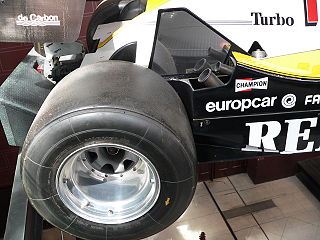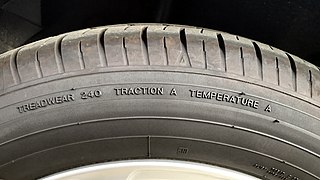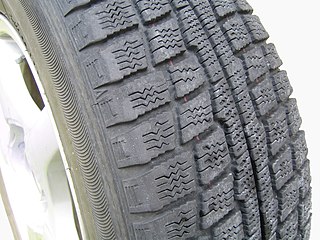
Pirelli & C. S.p.A. is an Italian multinational tyre manufacturer based in the city of Milan, Italy. The company, which has been listed on the Borsa Italiana since 1922, is the 6th-largest tyre manufacturer and is focused on the consumer production of tyres for cars, motorcycles and bicycles. It is present in Europe, the Asia-Pacific, Latin America, North America and the Post-Soviet states, operating commercially in over 160 countries. It has 19 manufacturing sites in 13 countries and a network of around 14,600 distributors and retailers. In 2015, China National Chemical Corp. Ltd. (ChemChina) took controlling interest of Pirelli; with the Chinese state-owned company agreeing to maintain the tyre company's ownership structure until 2023.

A tire or tyre is a ring-shaped component that surrounds a wheel's rim to transfer a vehicle's load from the axle through the wheel to the ground and to provide traction on the surface over which the wheel travels. Most tires, such as those for automobiles and bicycles, are pneumatically inflated structures, providing a flexible cushion that absorbs shock as the tire rolls over rough features on the surface. Tires provide a footprint, called a contact patch, designed to match the vehicle's weight and the bearing on the surface that it rolls over by exerting a pressure that will avoid deforming the surface.

A racing slick or slick tyre is a type of tyre that has a smooth tread used mostly in auto racing. The first production slick tyre was developed by M&H Tires in the early 1950s for use in drag racing. By eliminating any grooves cut into the tread, such tyres provide the largest possible contact patch to the road, and maximize dry traction for any given tyre dimension; see Performance. Slick tyres are used on race tracks and in road racing, where acceleration, steering and braking require maximum traction from each wheel. Slick tyres are typically used on only the driven (powered) wheels in drag racing, where the only concern is maximum traction to put power to the ground, and are not used in rallying.

Aquaplaning or hydroplaning by the tires of a road vehicle, aircraft or other wheeled vehicle occurs when a layer of water builds between the wheels of the vehicle and the road surface, leading to a loss of traction that prevents the vehicle from responding to control inputs. If it occurs to all wheels simultaneously, the vehicle becomes, in effect, an uncontrolled sled. Aquaplaning is a different phenomenon from when water on the surface of the roadway merely acts as a lubricant. Traction is diminished on wet pavement even when aquaplaning is not occurring.

The tread of a tire or track refers to the rubber on its circumference that makes contact with the road or the ground. As tires are used, the tread is worn off, limiting its effectiveness in providing traction. A worn tire can often be retreaded.

Siping is a process of cutting thin slits across a rubber surface to improve traction in wet or icy conditions.

Uniform Tire Quality Grading, commonly abbreviated as UTQG, is a set of standards for passenger car tires that measures a tire's treadwear, temperature resistance and traction. The UTQG was created by the National Highway Traffic Safety Administration in 1978, a branch of the United States Department of Transportation (DOT). All passenger car tires manufactured for sale in the United States since March 31, 1979 are federally mandated to have the UTQG ratings on their sidewall as part of the DOT approval process, in which non-DOT approved tires are not legal for street use in the United States. Light truck tires are not required to have a UTQG. It is not to be confused with the tire code, a supplemental and global standard measuring tire dimensions, load-bearing ability and maximum speed, maintained by tire industry trade organizations and the International Organization for Standardization.

Snow tires, also known as winter tires, are tires designed for use on snow and ice. Snow tires have a tread design with larger gaps than those on conventional tires, increasing traction on snow and ice. Such tires that have passed a specific winter traction performance test are entitled to display a 3PMSF symbol on their sidewalls. Tires designed for winter conditions are optimized to drive at temperatures below 7 °C (45 °F). Studded tires are a type of snow tires which have metal or ceramic studs that protrude from the tire to increase traction on hard-packed snow or ice. Studs abrade dry pavement, causing dust and creating wear in the wheel path. Regulations that require the use of snow tires or permit the use of studs vary by country in Asia and Europe, and by state or province in North America.

Inspection and maintenance of tires is about inspecting for wear and damage on tires so that adjustments or measures can be made to take better care of the tires so that they last longer, or to detect or predict if repairs or replacement of the tires becomes necessary. Tire maintenance for motor vehicles is based on several factors. The chief reason for tire replacement is friction from moving contact with road surfaces, causing the tread on the outer perimeter of tires to eventually wear away. When the tread depth becomes too shallow, like for example below 3.2 mm, the tire is worn out and should be replaced. The same rims can usually be used throughout the lifetime of the car. Other problems encountered in tire maintenance include:

Formula One tyres play a significant role in the performance of a Formula One car. The tyres have undergone major changes throughout the history of Formula One with different manufacturers and specifications used in the sport.

A bicycle tire is a tire that fits on the wheel of a bicycle or similar vehicle. These tires may also be used on tricycles, wheelchairs, and handcycles, frequently for racing. Bicycle tires provide an important source of suspension, generate the lateral forces necessary for balancing and turning, and generate the longitudinal forces necessary for propulsion and braking. Although the use of a pneumatic tire greatly reduces rolling resistance compared to the use of a rigid wheel or solid tire, the tires are still typically the second largest source, after wind resistance, of power consumption on a level road. The modern detachable pneumatic bicycle tire contributed to the popularity and eventual dominance of the safety bicycle.

A motorcycle tyre is the outer part of motorcycle wheel, attached to the rim, providing traction, resisting wear, absorbing surface irregularities, and allowing the motorcycle to turn via countersteering. The two tyres' contact patches are the motorcycle's connection to the ground, and so are fundamental to the motorcycle's suspension behaviour, and critically affect safety, braking, fuel economy, noise, and rider comfort.
The following is a glossary of terminology used in motorsport, along with explanations of their meanings.

The Tyre Label is a mark for motor vehicle tyres. Manufacturers of tyres for cars, light and heavy trucks must specify fuel consumption, wet grip and noise classification of every tyre sold in EU market starting in November 2012.

The 2011 British Grand Prix was a Formula One motor race held on 10 July 2011 at the Silverstone Circuit in Northamptonshire and Buckinghamshire, England, and won by Fernando Alonso. It was the ninth race of the 2011 season, and saw the introduction of a ban on off-throttle blown diffusers, the practice of forcing the engine to continue to produce exhaust gasses to generate downforce when drivers are not using the throttle. The race also saw the Formula One debut of future Grand Prix winner Daniel Ricciardo.

The 2011 Hungarian Grand Prix was a Formula One motor race that was held on 31 July 2011 at the Hungaroring in Mogyoród, near Budapest, Hungary It was the eleventh round of the 2011 Formula One season, and the 27th running of the Hungarian Grand Prix, and the 26th time it had been held as a round of the World Championship. The 70-lap race was won by McLaren's Jenson Button, in his 200th Grand Prix start, after starting from third on the grid. Championship leader Sebastian Vettel, who started the race from pole position, finished in second place for Red Bull Racing, and Fernando Alonso completed the podium in third position for Ferrari.

The following outline is provided as an overview of and topical guide to tires:

Bar grip tyres, or 'NDT' in US military parlance, are an early tyre tread pattern developed for off-road use.

The FIA Formula 2 Championship is a second-tier single-seater championship organized by the Fédération Internationale de l'Automobile (FIA). Held on racing circuits, the championship was introduced in 2017, following the rebranding of the long-term Formula One feeder series GP2. The series' original founders were Flavio Briatore and current managing director Bruno Michel.

The FIA Formula 3 Championship is a third-tier international single-seater racing championship and organised by the Fédération Internationale de l'Automobile (FIA). The championship launched in 2019 as a feeder series for the FIA Formula 1 World Championship and FIA Formula 2 Championships. It was the result of a merger between two third-tier single-seater racing championships, the GP3 Series and the FIA Formula 3 European Championship as it was announced on 10 March 2018. The championship is part of the FIA Global Pathway consolidation project plan. Unlike its predecessor, the Formula 3 European Championship, the series runs exclusively in support of Formula One races.




















